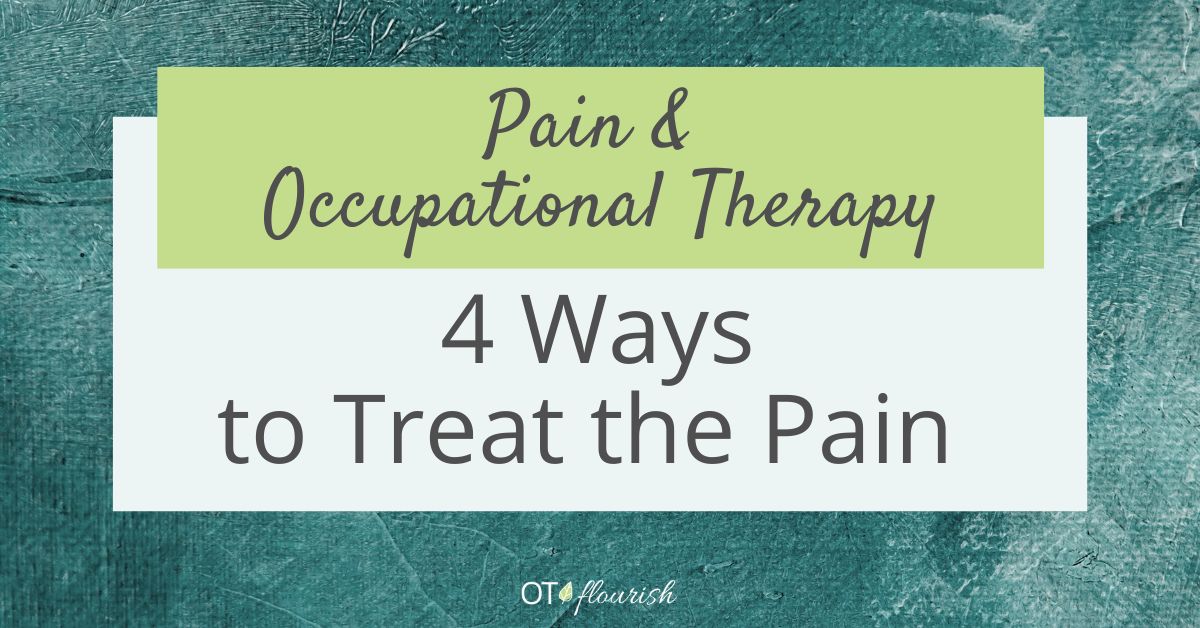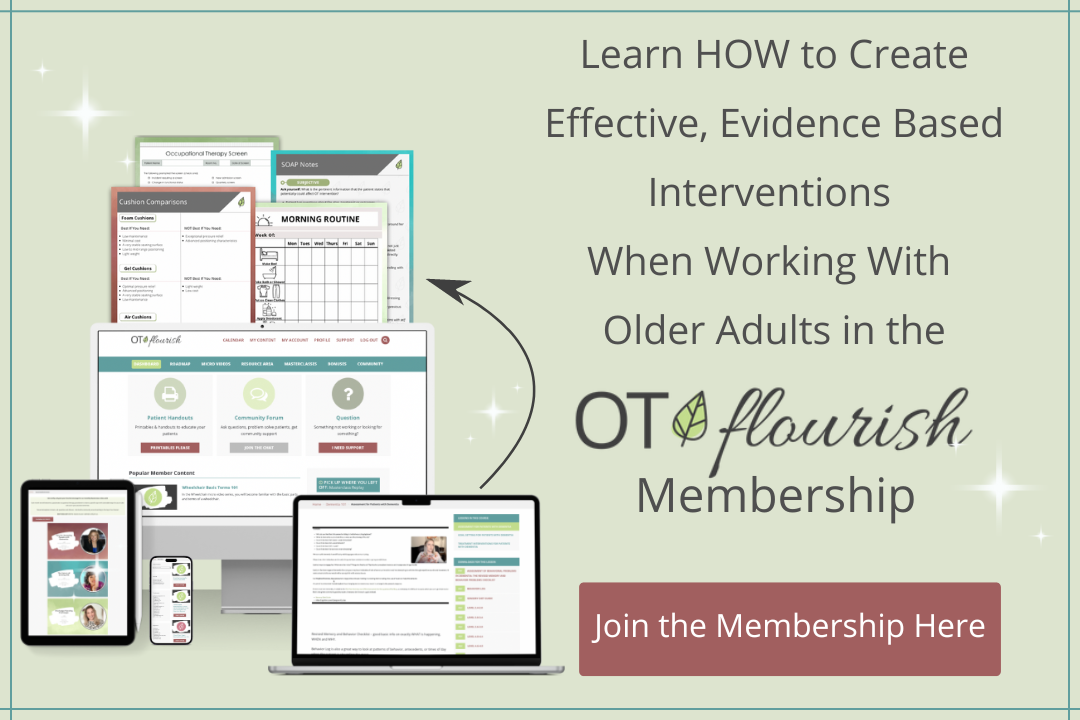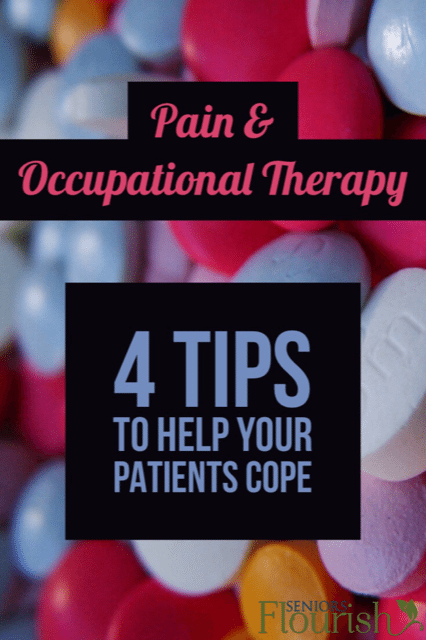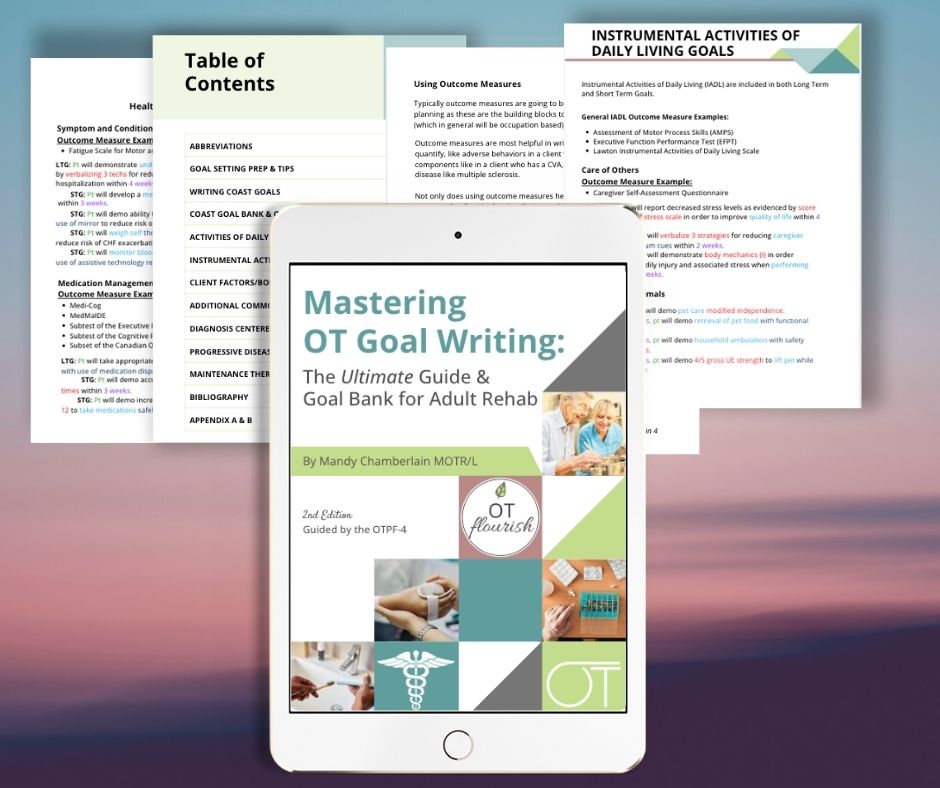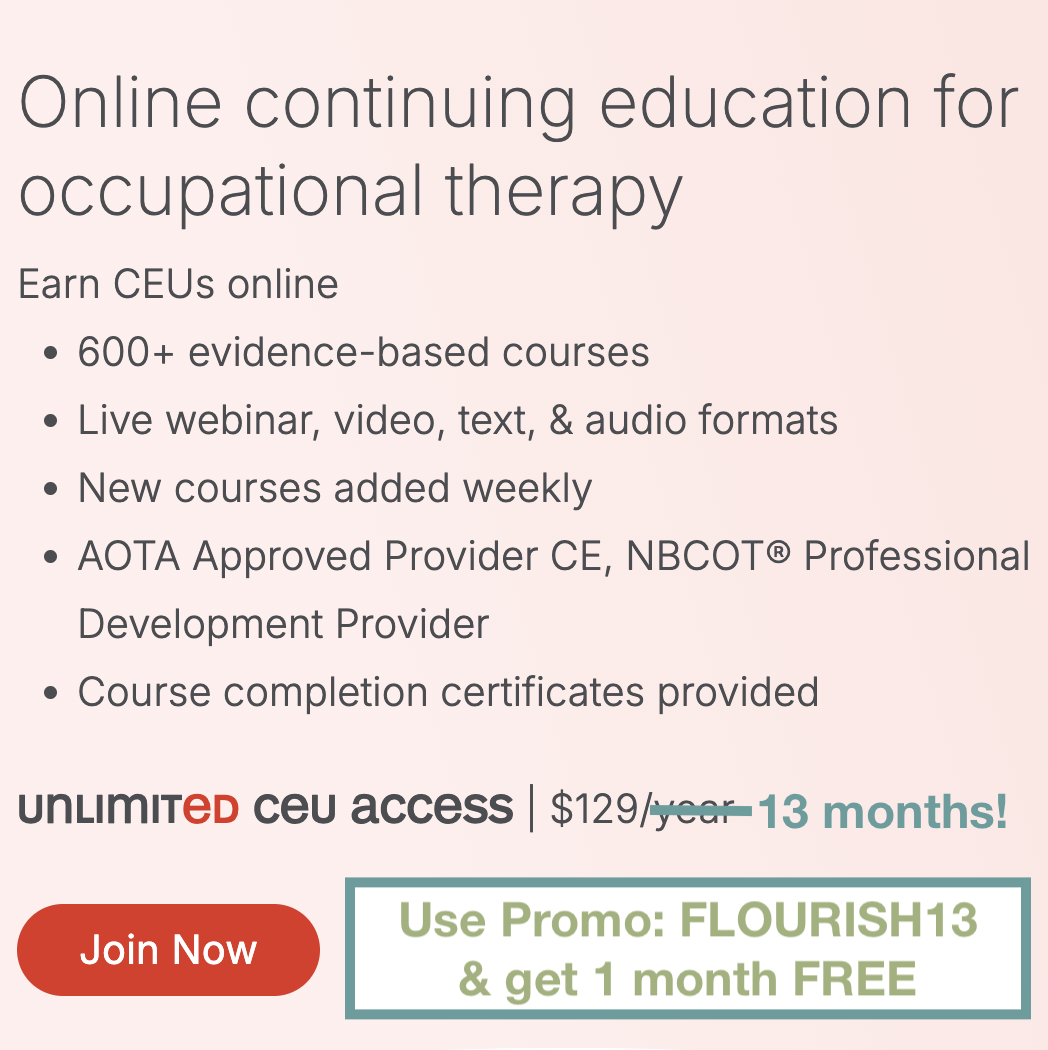Pain and occupational therapy must be addressed to help our patients achieve their goals and improve their quality of life, as it is such a limiting aspect of occupational performance. We will be looking at how the patient’s outlook and experience around pain and 4 ways we can help them overcome some of these challenges through pain management and occupational therapy, but before we get started, let’s answer the basic questions and terms…
Does occupational therapy help with pain?
Short answer – Yes!
Long answer – Pain and occupational therapy absolutely have a role! We can provide several interventions and strategies to help individuals better manage their pain and improve their overall functioning, but also using techniques like therapeutic use of self can be very effective in implementing these techniques.
We address pain from a holistic perspective and because we are focusing on improving occupational performance and quality of life, we are a valuable component of the patient’s comprehensive pain management plan.
Catastrophizing:
A psychological experience regarding pain that includes being unable to focus on anything else but the pain, rumination, magnification of pain and feeling helpless about pain. We also discussed this in the podcast, Coping Strategies for Pelvic Pain in Older Adults. Pain catastrophizing is one of the most powerful predictors of pain suffering and the pain experience (from Less Pain, Fewer Pills: Avoid the Dangers of Prescription Opioids and Gain Control Over Chronic Pain by Beth Darnall PhD)
Do you know the most important factor in the pain experience?
It is not:
- Injury
- Infection
- Disability
- Age
- Comorbitities
IT IS FEAR.
Noxious Stimuli + Fear = More Pain
While this does not mean pain is “all in your head,” it does mean we can take steps as occupational therapy practitioners to help patient’s calm their nervous systems and thereby deal and cope with pain better.
What are coping methods for pain?
4 ways to work on occupational therapy pain management and help your patient cope and avoid catastrophizing, ultimately making it worse include:
- choose your facial expressions wisely
- choose your words carefully in reference to pain
- suggest new rumination
- PLAY!
Let’s dig into each one more specifically.
1. Choose your facial expressions wisely
Humans have mirror neurons. We have the tendency to do what others around us are doing.
They smile, we smile. They laugh, we laugh. They tense, we tense.
They cry, we cry.
So while the phrase “fake it till you make it” might benefit many in their chosen profession, it is crucial when dealing with patients experiencing pain.
- You bring calm. Even if you are not calm. Repeat after me: YOU BRING CALM!
- You bring confidence and kindness.
- You bring encouragement and steadiness.
- Do not show pity. You recognize their struggle, but YOU BRING CALM!
Humans have a natural tendency to mimic and mirror facial expressions. This phenomenon, known as emotional contagion, can occur during interactions between healthcare professionals and patients. When healthcare professionals display positive facial expressions, it can elicit positive emotions in patients, such as feelings of comfort and safety. This emotional contagion can help alleviate anxiety and distress associated with pain.
Empathy and kindness goes a long way – it reinforces the idea that their pain is taken seriously and that their needs are being addressed. This positive reinforcement can contribute to a more positive pain experience and reduce the perceived severity of pain.
2. Choose your words carefully in reference to pain
Every time you reference pain, you prime your client’s brain to think about it.
You increase attention to the pain, the stress, the FEAR.
Stop talking about it.
When you discuss the human body reference its amazing capability to adapt, to heal, to adjust, to learn… Don’t be patronizing, but take every opportunity to reword what they are experiencing like:
“Yes this is hard, but healing is happening!” or
“We are finding a new way to do things that work for your body! Isn’t that exciting?”
Reconsider pain as the fifth vital sign. It unnecessary to ask about it. If it’s a limiting factor, your clinical reasoning and your patient’s own words will let you know.
Just by asking, you are potentially intensifying the pain!
It is important to note that not talking about pain should not be the sole coping strategy, especially in cases where pain management requires an entire medical professional team. It is crucial to strike a balance between acknowledging and addressing pain while also allowing space for other aspects of life. Each person’s coping needs and preferences may vary, so finding the right balance is a personal journey that may require guidance from healthcare professionals, occupational therapy practitioners or support networks.
3. Suggest new rumination
We all have an inner dialogue. Help create a better script for those in pain. Encouraging patients to develop positive affirmations and coping statements can help reframe their thoughts and beliefs about pain. By consciously choosing and repeating statements that promote resilience, strength, and hope, patients can cultivate a more positive mindset and reduce the impact of pain on their daily lives.
Using catastrophic language, such as describing pain as “unbearable” can intensify the perception of pain and create a sense of helplessness. Encouraging patients to use empowered language that focuses on their ability to cope, adapt, and take control can foster a more positive mindset and reduce the emotional impact of pain.
If anyone you are working with is displaying pain catastrophization, try:
-
- “Let’s rewrite that script ok?”
- “I see you are worried. You’ve never broken a bone in your life, BUT I also see a woman who raised four boys, who has grit. From now on, every time I think you’ve forgotten, I will remind you that you are a BEAST who can do HARD things.”
Have them say it. They won’t want to, but have them say it.
Changing how patients talk about their pain can empower them to take an active role in managing their pain, promote resilience, and improve their overall well-being. Healthcare professionals play a crucial role in guiding patients towards adopting more constructive and empowering language and communication patterns related to their pain experience.
Positive words have power – don’t be afraid to be cheesy!
4. PLAY!!!
How many people with chronic pain, have lost vital aspects of their personalities? Frivolity, joking, teasing, even fart jokes… this may be the real medicine they need.
What does play provide for people in pain?
- Distraction: Play serves as a powerful distraction from pain. When individuals are engrossed in enjoyable and stimulating activities, their focus shifts away from the pain, leading to a reduction in perceived pain intensity. Engaging in play can divert attention from discomfort and provide relief.
- Endorphin Release: Playful activities stimulate the release of endorphins, which are natural pain-relieving chemicals in the brain. Endorphins promote feelings of happiness, relaxation, and euphoria, effectively reducing pain perception and improving mood.
- Stress Reduction: Play is known to reduce stress levels, and chronic pain often accompanies high levels of stress and anxiety. Engaging in playful activities activates the parasympathetic nervous system, promoting relaxation and reducing stress. This, in turn, can alleviate pain and enhance overall well-being.
- Physical Movement: Many forms of play involve physical movement, which can have a positive impact on pain management. Gentle exercise and movement release natural pain-relieving chemicals, improve circulation, and enhance flexibility and muscle strength. Regular physical activity through play can help manage chronic pain conditions such as arthritis or fibromyalgia.
- Cognitive Shift: Engaging in play shifts the cognitive focus from pain to pleasurable experiences. It encourages a positive mindset and helps individuals view their pain in a different light. This cognitive shift can promote resilience, enhance coping strategies, and reduce the impact of pain on daily life.
- Social Connection: Play often involves social interaction, fostering connections and a sense of belonging. Engaging in play with others can provide emotional support, increase feelings of happiness, and decrease feelings of isolation and loneliness, which are commonly associated with chronic pain.
- Increased Resilience: Playfulness encourages a playful mindset and cultivates resilience. It promotes a positive attitude, adaptability, and creativity in finding ways to cope with pain. Developing a resilient mindset through play can help individuals better manage pain challenges and navigate daily life more effectively.
Incorporating play into daily routines can be beneficial for adults experiencing pain. It is important to find activities that align with personal interests and preferences. Whether it involves engaging in hobbies, creative pursuits, games, sports, or any form of recreational activity, play can significantly contribute to pain relief, improved mood, and overall well-being in adults.
Resources:
Pain Reframed Podcast
About our Guest Blogger: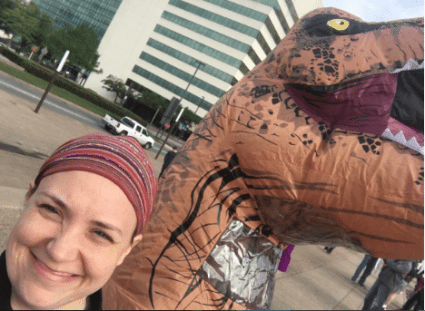
Janie Oyakawa OTR, is a wife and mother of six smart kiddos. She worked in OT for a while after graduating from VCU. The SNF environment and home health, without the online support that exists now, caused severe burnout, so she became a stay at home mom with her growing family. She returned to OT in 2016.
She prides herself as somewhat of a hippy skeptic. Lover of science and research as well as meditation and yoga. She may not believe in chakras, but you just might find her in random places of the inpatient rehab she works at teaching deep breathing and mindfulness. Her special interests are pain management and helping people reduce opioid use.
Looking for more information about pain?
Check out the Occupational Therapy for Chronic Pain Management, Explaining Pain Cycles and Assessment of Chronic Pain micro videos and pain management occupational therapy handouts in our membership, the OT Accelerator.

